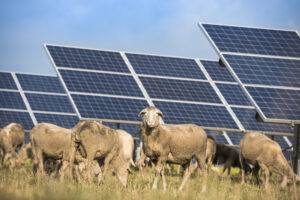 Chad Higgins, a professor at Oregon State University, is a renowned expert in agrivoltaics and their impact on sheep grazing. He is currently involved in a significant $500 million solar farm project near Glenrock, Wyoming.
Chad Higgins, a professor at Oregon State University, is a renowned expert in agrivoltaics and their impact on sheep grazing. He is currently involved in a significant $500 million solar farm project near Glenrock, Wyoming.
Chad Higgins: Leading Authority on Solar Panels and Sheep Grazing
BrightNight LLC is planning a 500-megawatt solar farm near Glenrock, Wyoming, with an interest in integrating sheep grazing to honour local traditions. To achieve this, they have sought the expertise of Chad Higgins, an associate professor at Oregon State University known for his work in combining agriculture and solar energy.
Higgins has been collaborating on the project since 2022 and is considered a pioneer in agrivoltaics. His research focuses on the interaction between solar panels and grazing animals, particularly sheep.
A Fusion of Livestock and Sustainable Energy
Incorporating sheep grazing under solar panels is not just a concept but a reality being implemented in various locations. Higgins conducted experiments at Oregon State University’s Sheep Center where sheep grazed beneath solar arrays.
The American Solar Grazing Association predicts that by 2023, more than 50,000 acres of solar farms will accommodate grazing sheep. Studies show that sheep actually prefer feeding and resting under solar panels rather than in open fields, indicating that solar grazing not only offers sheep a comfortable environment but also facilitates their feeding.
Additionally, having sheep graze on solar farms reduces the need for mowing grass or using herbicides under the panels. This practice benefits the land by promoting environmental sustainability and biodiversity on solar farms.
Advantages of Solar Grazing
Solar grazing presents advantages for both solar farm operators and livestock owners:
- It lowers vegetation management costs for solar operators.
- Livestock owners can generate additional income by leasing their animals.
- It enhances soil health, and fosters increased plant and animal diversity on solar farms.
- It promotes synergy between green energy production and sustainable agriculture.
- It raises local interest and fosters support for solar energy initiatives.
Wyoming’s Solar Farm Endeavor
Wyoming is embracing renewable energy through projects like BrightNight LLC’s ambitious $500 million venture known as The Dutchman. Construction is scheduled to commence in March 2025, pending regulatory approval, contributing to Wyoming’s transition towards cleaner energy sources.
AES Corp. is also planning to build a $230 million wind farm in Converse County, highlighting Wyoming’s growing role in renewable energy production. These large-scale initiatives are creating employment opportunities and boosting the economies of rural communities.
Challenges and Prospects
While solar grazing holds promise for Wyoming’s energy future, challenges such as water scarcity and land use regulations must be addressed. Given Wyoming’s arid climate, prudent water management is vital when establishing new solar farms.
Effective legislation is essential for the success of solar projects while safeguarding the environment and the well-being of local residents. Collaboration among governments, businesses, and communities is crucial to navigate these challenges and strike a balance between economic development and environmental preservation.
In Conclusion
As we transition towards cleaner energy sources, innovative practices like solar grazing showcase how the land can be optimally utilized while preserving the environment. Through ongoing research and collaboration, we are likely to witness more solar farms integrating sheep grazing, bridging the gap between agriculture and sustainable energy production.
The integration of farming practices with solar energy generation enables communities to enjoy the benefits of both industries while minimizing environmental impact. This approach also enhances resilience against climate change. Initiatives like Wyoming’s $500 million solar project and the expertise of professionals like Chad Higgins pave the way for a more sustainable future.
Leave a Reply